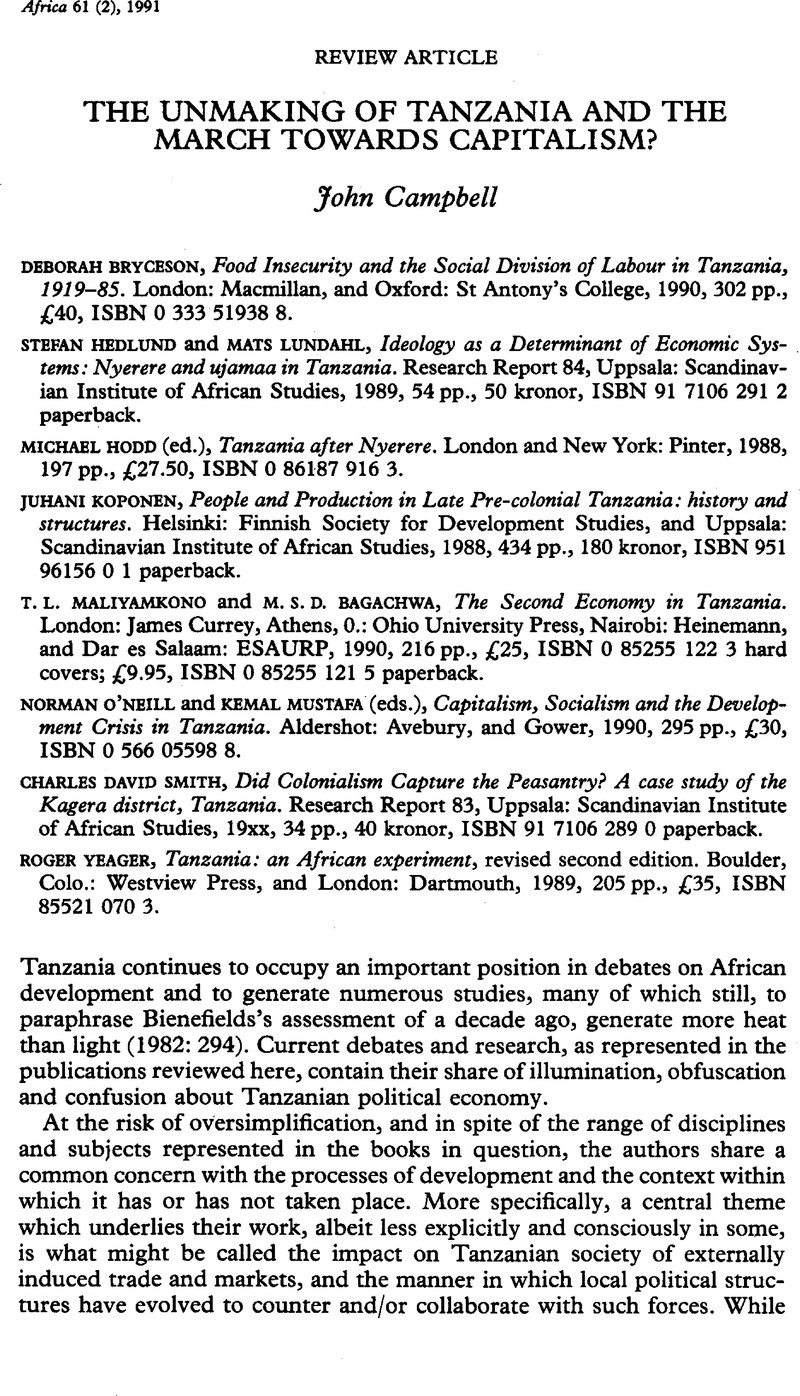No CrossRef data available.
Article contents
The unmaking of Tanzania and the march towards capitalism?
Published online by Cambridge University Press: 07 December 2011
Abstract
An abstract is not available for this content so a preview has been provided. Please use the Get access link above for information on how to access this content.

- Type
- Review Article
- Information
- Copyright
- Copyright © International African Institute 1991
References
Bernstein, H. 1990. ‘Taking the part of peasants’, in Bernstein, H.et al. (eds.), The Food Question, London: Earthscan.Google Scholar
Bernstein, H.et al. (eds.). 1990. The Food Question: profits v. people. London: Earthscan.Google Scholar
Bienefeld, M. 1975a. The Self-employed of Urban Tanzania, paper 75.11. Economic Research Bureau, University of Dar es Salaam.Google Scholar
Bienefeld, M. 1975b. ‘The informal sector and peripheral capitalism: the case of Tanzania’, IDS Bulletin 6 (3), 53–73.Google Scholar
Bienefeld, M. 1982. ‘Tanzania: model or anti-model?’, in Bienefeld, M. and Godfrey, M. (eds.), The Struggle for Development: national strategies in an international context, New York: Wiley.Google Scholar
Bromley, R., and Gerry, C. (eds.). 1979. Casual Work and Poverty in Third World Cities. New York: Wiley.Google Scholar
Bryceson, D. F. 1987. ‘A century of food supply in Dar es Salaam’, in Guyer, J. I. (ed.), Feeding African Cities, Manchester: Manchester University Press for the International African Institute.Google Scholar
Clapham, C. 1988. Transformation and Continuity in Revolutionary Ethiopia. Cambridge: Cambridge University Press.Google Scholar
Cohen, J. M., and Isaksson, N. I. 1988. ‘Food production strategy debates in revolutionary Ethiopia’, World Development 16 (3).CrossRefGoogle Scholar
Griffin, K. and Hayes, R. 1985. ‘Problems of agricultural development in socialist Ethiopia: an overview and a suggested strategy’. Journal of Peasant Studies 13 (1).CrossRefGoogle Scholar
Guyer, J. I. 1987. ‘Introduction’, in Guyer, J. I. (ed.), Feeding African Cities: studies in regional social history, Manchester: Manchester University Press for the International African Institute.Google Scholar
Harding, P., and Jenkins, R. 1989. The Myth of the Hidden Economy: towards a new understanding of informal economic activity. Milton Keynes: Open University Press.Google Scholar
Helleiner, G. K. 1987. ‘Stabilisation, adjustment, and the poor’, World Development 15 (12), 1499–513.CrossRefGoogle Scholar
Hyden, G. 1980. Beyond Ujamaa in Tanzania: underdevelopment and an uncaptured peasantry. London: Heinemann.CrossRefGoogle Scholar
Iliffe, J. 1979. A Modern History of Tanganyika. Cambridge: Cambridge University Press.CrossRefGoogle Scholar
Johnson, D. H., and Anderson, D. M. 1988. ‘Introduction: ecology and society in north-east African history’, in Johnson, D. H. and Anderson, D. M. (eds.), The Ecology of Survival, Boulder, Colo: Westview Press.Google Scholar
Kasfir, N. 1986. ‘Are African peasants self-sufficient? A review of Goran Hyden’, Development and Change 17 (2).CrossRefGoogle Scholar
Kjekshus, H. 1974. ‘Socialism and participation: some concluding remarks’, in Election Study Committee (eds.), Socialism and Participation: Tanzania's 1970 national elections. Dar es Salaam: Tanzania Publishing House.Google Scholar
Kjekshus, H. 1977. Ecology Control and Economic Development in East African History: the case of Tanzania, 1850-1950. London: Heinemann.CrossRefGoogle Scholar
Mars, T., and White, G. (eds.). 1986. ‘Developmental States and African Agriculture’, IDS Bulletin 17 (1).Google Scholar
Mbilinyi, M. 1990. ‘Structural adjustment, agribusiness and rural women in Tanzania’, in Bernstein, H.et al. (eds.), The Food Question, London: Earthscan.Google Scholar
McCann, J. 1987. ‘The social impact of drought in Ethiopia: oxen, households and some implications for rehabilitation’, in Glantz, M. (ed.), Drought and Hunger in Africa: denying famine a future, Cambridge: Cambridge University Press.Google Scholar
Mitchell, J. C. (ed.). 1969. Social Networks in Urban Situations. Manchester: Manchester University Press.Google Scholar
Onimode, B. (ed.). 1989. The IMF, the World Bank and the African Debt, two volumes. London: Zed Press.Google Scholar
Sabot, R. 1979. Economic Development and Urban Migration: Tanzania, 1900-71. Oxford: Oxford University Press.Google Scholar
Slater, H. 1986. ‘Dar es Salaam and the post-national historiography of Africa’, in Jiewsiewicki, B. and Newbury, D. (eds.), African Historiography: what history for which Africa? Beverly Hills and London: Sage.Google Scholar
Tripp, A. M. 1988. ‘Defending the Right to Subsist: the state v. the urban informal economy in Tanzania’, paper presented to the African Studies Association, Chicago, October.Google Scholar
UDASA (University of Dar es Salaam Staff Assembly). 1990. Special Issue on Academic Freedom and Social Responsibility of Academics, UDASA Newslet-terIForum, 11 (June).Google Scholar
White, G. 1986. ‘State and Market in Post-Mao China’, seminar paper given at the Institute of Development Studies, University of Sussex, September.Google Scholar




